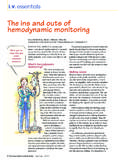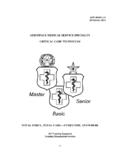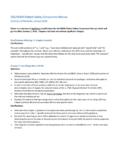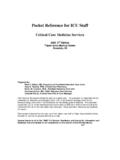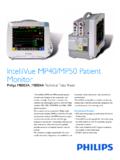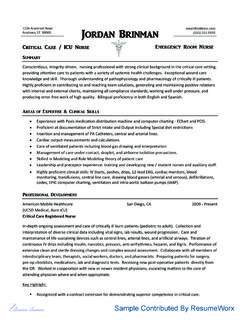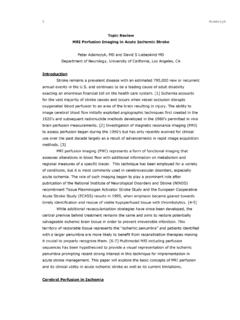Transcription of Arterial waveform analysis - SEMES
1 5 Arterial waveform analysisStephen A. Esper, MD, MBA, Assistant Professor ofAnesthesiologya,*,Michael R. Pinsky, MD, CM, Dr hc, Professor of Critical CareMedicine, Bioengineering, Cardiovascular Diseases andAnesthesiologya,baDepartment of Anesthesiology, University of Pittsburgh, Pittsburgh, PA, USAbDepartment of Critical Care Medicine, University of Pittsburgh, Pittsburgh, PA, USAK eywords: Arterial waveformarterial lineminimally invasive monitoringdevicescardiac outputstroke volume variationThe bedside measurement of continuous Arterial pressure valuesfrom waveform analysis has been routinely available via indwellingarterial catheterization for>50 years.
2 Invasive blood pressuremonitoring has been utilized in critically ill patients, in both theoperating room and critical care units, to facilitate rapid diagnoses ofcardiovascular insufficiency and monitor response to treatmentsaimed at correcting abnormalities before the consequences of eitherhypo- or hypertension are seen. Minimally invasive techniques toestimate cardiac output (CO) have gained increased appeal. This hasled to the increased interest in Arterial waveform analysis to providethis important information, as it is measured continuously in manyoperating rooms and intensive care units.
3 Arterial waveform analysisalso allows for the calculation of many so-called derived parametersintrinsically created by this pulse pressure profile. These include es-timatesofleftventricularstrokevolume( SV),CO,vascularresistance,and during positive-pressure breathing, SV variation, and pulsepressure variation. This article focuses on the principles of arterialwaveform analysis and their determinants, components of the arte-rial system, and Arterial pulse contour. It will also address theadvantage of measuring real-time CO by the Arterial waveform andthe benefits to measuring SV variation.
4 Arterial waveform analysishasgainedalargeinterestintheover allassessmentandmanagementof the critically ill and those at a risk of hemodynamic deterioration. 2014 Elsevier Ltd. All rights reserved.*Corresponding author. Department of Anesthesiology, 200 Lothrop Street, Pittsburgh, 15261 PA, Esper).Contents lists available atScienceDirectBest Practice & Research ClinicalAnaesthesiologyjournal 2014 Elsevier Ltd. All rights Practice & Research Clinical Anaesthesiology 28 (2014) 363e380 IntroductionThe bedside measurement of continuous Arterial pressure values from waveform analysis has beenroutinely available via indwelling Arterial catheterization for>50 years.
5 Invasive blood pressuremonitoring has been utilized in critically ill patients, in both the operating room and critical care units,to facilitate rapid diagnoses of cardiovascular insufficiency and monitor response to treatments aimedat correcting abnormalities before the consequences of either hypo- or hypertension are blood pressure wasfirst directly measured by Stephen Hales in 1733, when he used a 90-long glass tube with aflexible connector (the trachea of a goose) and measured the pressures at thefemoral and carotid arteries[1]. Other scientists and physicians improved on this method, includingDaniel Bernoulli[2]and Jean-Louis Poiseuille who, in 1828, used a mercury-filled U-tube to determinethe pressure at multiple points along the aorta[3].
6 Thefirst clinically relevant placement of an arterialcatheter was accomplished in 1949 by Peterson and colleagues who described the following meth-odology: A small plastic catheter, inserted into an artery through a needle, is left in the artery whenthe needle is withdrawn. Attached to a capacitance manometer, this technique permits recording forlong periods of time without discomfort and allows relatively free mobility of the subject. [4]Sincethat time, multiple techniques have been elucidated by Peirce[5]and Seldinger[6]. Seldingerdescribed the catheter-over-wire technique commonly used today.
7 As of 1990,>8 million invasivearterial catheters had been placed. One added advantage of an invasive Arterial catheter is the ability toeasily draw blood samples to measure levels of various including hemoglobin and electrolytes,allowing greater ease at diagnosis and managing disease. As medical technology improved, noninva-sive technology was developed to provide continuous Arterial waveform monitoring using plethys-mographic principles with devices placed on afinger or wrist, that is, a continuous noninvasive arterialpressure (CNAP) monitor[7]and NexFin[8](BMEYE, Amsterdam, the Netherlands) devices.
8 Somenoninvasive devices require calibration and others do monitoring in the operating room and the intensive care unit has evolved over timeby the use of both Arterial pressure monitoring and pulmonary artery catheter (PAC)-derived measures include pulmonary artery pressure, pulmonary artery occlusion pressure, mixedvenous oxygen saturation, and cardiac output (CO) by the thermodilution technique. Although it wouldseem that these invasive monitoring techniques to estimate CO would be useful in patient manage-ment, studies do not show improved outcomes when compared to their lack of use.
9 There have beenmultiple randomized controlled trials that have reported no evidence of benefit or harm from the useof the PAC[9], and some literature has indicated that there may be an increase in complications sec-ondary to the use of pulmonary artery catheterization[10e12]. There may be a few reasons why therehas been a failure to show the benefit of PAC: some of the studies may not have used treatmentsrequiring CO values to drive resuscitation, the treatments in the studies may not have been proven toimprove outcome, and the groups studied are too heterogeneous to document a benefit[13].
10 Because of this overall lack of interest in the continued widespread use of the PAC, minimallyinvasive techniques to estimate CO have gained increased appeal. This has led to increased interestin Arterial waveform analysis to provide this important information. The Arterial waveform ismeasured continuously in many operating rooms and intensive care units, and obtaining thearterial pressure waveform can be accomplished by simple catheterization and even benefit is the continuous measurement of Arterial pressure with decreased risk to the cost that exists is the purchase of a device that allows for numerical computation but does notrequire further specialty staff.


